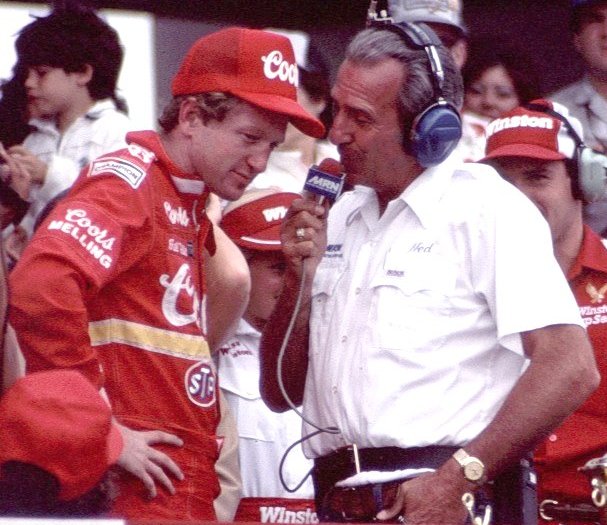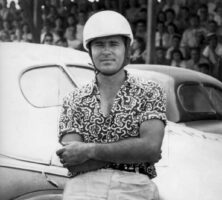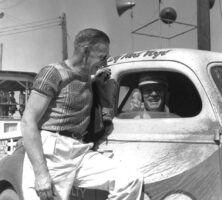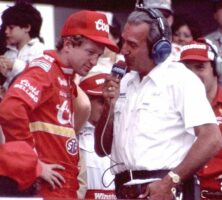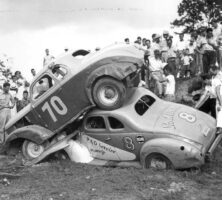Georgia drivers, car owners, mechanics, and speedways have long played an important role in the establishment, development, and growing popularity of the National Association of Stock Car Racing (NASCAR) sport.

Photograph by Wikimedia
Many observers consider Dawsonville one of the birthplaces of NASCAR. Indeed, several of the most popular and influential individuals in the early history of southern stock car racing came from this north Georgia town. Although he seldom drove in races, Raymond Parks, a native of Dawson County and a prominent Atlanta liquor-store owner, financed operations for a number of the most important early racers. In 1938 Parks’s moonshine-running cousins Roy Hall (memorialized in the Jim Croce song “Rapid Roy, That Stock Car Boy”) and Lloyd Seay, both from Dawson County, persuaded Parks to bankroll their fledgling racing careers. Parks provided his cousins with top-notch cars prepared by the Atlanta garage owner and mechanic Red Vogt.
Hall and Seay dominated the stock-car racing scene in the Southeast and Midwest in the late 1930s and early 1940s. Unfortunately, despite playing such a foundational role, neither was able to take advantage of the growth of the sport after World War II (1941-45). In 1941 Seay, arguing with his cousin Woodrow Anderson about a shipment of sugar, was fatally shot. Hall was too old to duplicate his prewar success in the postwar era.

Georgia Automobile Racing Hall of Fame Association Incorporated
Parks and Vogt, however, continued to play key roles in NASCAR’s early success. Both participated in the 1947 organizational meetings at the Streamline Hotel in Daytona Beach, Florida, that created the National Association for Stock Car Auto Racing. Vogt came up with the name for the organization. Parks-owned and Vogt-prepared cars dominated NASCAR’s early years and launched the careers of such legends as Red Byron (1949 NASCAR Grand National Champion), Bob and Fonty Flock, Jack Smith, and Dawsonville native Gober Sosebee. Parks retired as a car owner in 1950, but Vogt continued to prepare championship cars well into the mid-1950s.
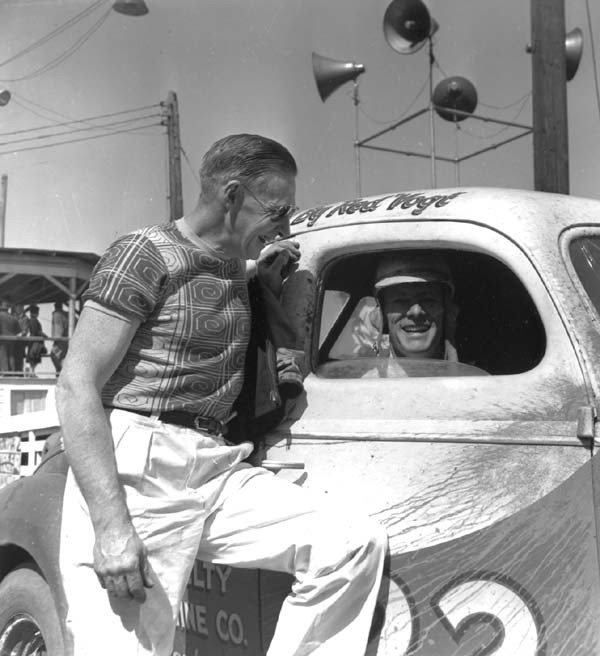
Georgia Automobile Racing Hall of Fame Association Incorporated
Although in later years Georgia drivers, owners, and mechanics would not play such a prominent role in NASCAR history, Georgians have continued to contribute in important ways. The most significant contributions since those early days have come from another Dawsonville native, Bill Elliott. In 1976 Elliott left north Georgia with his brothers Ernie (as engine builder and crew chief) and Dan (as transmission builder) to try his luck on the Winston Cup (later Sprint Cup) circuit. By the mid-1980s Elliott, often referred to as “Awesome Bill from Dawsonville,” became one of the most popular drivers on the tour. In 1985 he became the first driver to win $1 million in a single race, earning the nickname “Million-Dollar Bill.” In 1988 he won the Winston Cup championship. As of 2004 he had forty-four career wins (placing him on the all-time list), and as of 2002 had won NASCAR’s Most Popular Driver Award a record sixteen times. Elliot was inducted into the NASCAR Hall of Fame in 2015.
Georgia speedways have also played an important role in NASCAR’s development and growth. Indeed, every year since 1951 Georgia tracks have hosted at least two and as many as eight (1962 and 1964) races in NASCAR’s elite division, known today as the Sprint Cup series. Lakewood Speedway, a one-mile dirt track around a lake in south Atlanta, began hosting stock car races in 1938 and soon became one of the most important stock-car-racing venues in the Southeast, regularly attracting as many as 30,000 fans. Throughout the 1950s and 1960s, NASCAR sanctioned events at speedways in Augusta (fourteen races), Macon (fifteen), Savannah (twelve), and Jefferson (two). One of the more interesting and ironic incidents in NASCAR history occurred in 1967 at Middle Georgia Raceway in Macon when federal agents discovered under the ticket booth a whiskey still capable of producing 200 gallons every five days.
Built in 1960, the Atlanta Motor Speedway (actually located in Hampton, twenty-five miles south of Atlanta in Henry County) is the only track in Georgia still hosting Sprint Cup events. Although the track struggled in its early years, by 2004 it was one of the most modern and popular venues on the circuit. It hosts hundreds of thousands of stock-car racing fans at its two annual Sprint Cup series weekends.
On May 11, 2002, the history of NASCAR in Georgia came full circle when Thunder Road USA, a state-of-the-art motorsports museum and home of the Georgia Racing Hall of Fame, opened its doors in Dawsonville. At the museum’s dedication ceremony the Hall of Fame inducted Red Byron, Bill Elliott, Tim Flock, Roy Hall, Raymond Parks, Lloyd Seay, Gober Sosebee, and Red Vogt as its inaugural honorees.





